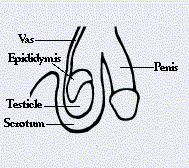If you think you don’t have to worry about cancer until after your fiftieth birthday, consider this fact: The risk of getting testicular cancer is highest between the ages of 15 and 35.
Testicular cancer is a relatively uncommon disease, with an estimated 7,100 cases in 1995. Yet, it is the most common form of cancer among men between the ages of 15 and 35. Fortunately, testicular cancer is one of the most treatable cancers when it’s caught early–and that’s simple to do because the testes are easily accessible for external examination. But don’t wait until you see your doctor. You can prevent this cancer from spreading to other organs and becoming deadly by performing regular self-examinations.

The testicles are two egg-shaped glands suspended below the penis in the scrotum. After puberty, the testes produce the male hormone testosterone, which is responsible for many male characteristics, such as body hair and deepening of the voice. The testes also produce the sperm that fertilizes a woman’s egg during reproduction.
Testicular cancer is the growth of a malignant (cancerous) tumor that originates in the testes. About 95 percent of masses in the testes are malignant, and if untreated, will grow and spread to other organs. Early detection is key to curing this disease.
While any man can develop testicular cancer, especially between the ages of 15 and 35, certain factors make men more vulnerable. These include:
- An undescended testicle (cryptochordism). If you have or have had an undescended testicle your risk of developing testicular cancer increases by three to 14 percent. This is particularly true if the testicle descended after age six or never descended at all.
- A testicle that has atrophied (wasted away or shrunk) as a result of the mumps or a viral infection.
- Family history. If you have a brother, or other family member who has had testicular cancer, you may have an increased risk for the disease.
- Exposure to diethylstilbestrol (DES) may be a risk factor for testicular cancer. From 1946 through the 1970’s, DES was used to treat pregnant women who had a high risk for miscarriage. Studies have already established a link between DES and vaginal cancer in the daughters of women who took DES during pregnancy. Studies are under way to see if such a link exists in sons as well (for more information, call the DES Cancer Network at 800-337-6384).
Your physician should include an examination of your testes during every routine medical examination. But since that probably occurs only once a year, you can improve your chance of detecting a problem as early as possible by performing a testicular self-examination (TSE) every month. Check for the following symptoms:
- A small, hard, usually painless lump, pea-size or greater, on the front or side of the testicle.
- Enlargement of a testicle or a change in a testicle’s consistency.
- A heavy feeling in the testes.
- Pain or discomfort, which may develop in one testicle or around the groin. But don’t wait for pain to develop. Report any signs or symptoms, such as swelling, lumps, or heaviness, to your doctor immediately.
- Enlargement of the lymph nodes in your groin or neck. The lymph nodes are glands that produce white blood cells and fight infection. When swollen, they feel round (about the size of a small marble or larger) and are often tender or painful.
If the scrotum doesn’t feel normal, your doctor will probably order an ultrasound exam, which uses sound waves to make a picture of the inside of your testes. A number of other examinations and tests may be needed to rule out or confirm cancer or to stage the disease (find out how far it has progressed). The following tests may be used for that purpose:
- Blood and urine samples to measure the function of other organs. Also, a blood test for tumor markers (chemicals produced by testicular tumors and released into the blood stream) can help detect the disease and monitor tumor activity before, during, and after treatment.
- Chest x-rays or computed tomography (CT) scans of the abdomen and chest (a CT scan is a painless procedure in which a beam moves around the body and forms a detailed picture on a computer screen that can show any developing abnormalities).
Once testicular cancer has been diagnosed, the physician has to determine what kind of cancer it is in order to decide what treatment is best. The tumors that form testicular cancer are divided into two major groups:
- 1) Seminomas, or cancer that originates in the sperm cells, account for 40 percent of all testicular cancers. This type of tumor is generally very responsive to radiation.
- 2) Non-seminomatous tumors make up the remaining 60 percent of testicular cancers and include several varieties of tumors. Approximately 30 to 40 percent of testicular cancers involve more than one type of tumor. A metastatic tumor (one that has spread to other parts of the body) may be made up of cells different from the cells of the primary, or first, tumor.
The next step is to determine the stage of the cancer, or how far it has spread. There are three main stages of testicular cancer:
- Stage I. Regardless of the size of the tumor, the cancer is limited to the testes and has not spread to the lymph nodes or other organs.
- Stage II. The cancer has begun to affect the area of the abdomen that lies behind the stomach (peritoneum). It also includes cancers that have spread to the lymph nodes, but not to a distant organ.
- Stage III. Cancer that has spread to one or more distant organs.
The good news is that testicular cancer is among the most curable of cancers, especially when detected early. Since the majority of all testicular tumors are cancerous, the first treatment is usually radical orchiectomy, which involves the surgical removal of the affected testicle and all of the adjoining tubes.
If only one testicle is involved, radical orchiectomy will probably not affect sexual function. However, it is important to find a surgeon experienced in this particular type of surgery because if lymph glands at the back of the abdomen have to be removed, the surgeon must take special care to protect the nerves associated with ejaculation. Nerves damaged during surgery can cause infertility.
After surgery, adjuvant (or additional) therapy is often needed depending on the type of tumor and the stage of the cancer.
In general, the treatments most commonly used are:
- Radiation therapy, which is usually highly effective against seminomas, may be used to eradicate the cancer or to shrink the size of tumors too large to operate.
- Chemotherapy (the use of powerful anti-cancer drugs) is usually used when the tumor cannot be completely removed surgically (such as with microscopic disease), the disease has spread to other organs, or the cancer recurs. Since chemotherapy may damage testicular function and cause infertility, a man may want to consider the option of storing sperm in a sperm bank prior to treatment.
In cases where the cancer has spread to the abdomen, additional surgery may be needed to remove affected lymph nodes in the area.
If treatment is successful, the disease goes into complete remission (it is no longer present). But there is still a chance that the cancer will return, particularly during the first two years after therapy. About 10 percent of men treated for testicular cancer experience a relapse. Still, almost all of these cases can also be cured–usually with chemotherapy–when caught early enough. Physicians monitor patients for recurrences with regular physical exams, CT scans of the abdomen, chest x-rays, and blood tests to measure tumor marker levels.
Men who are dissatisfied with their appearance after surgery can have an artificial testicle implanted. These implants are filled with silicone gel and have the weight and feel of a normal testicle. Recent concerns about a connection between the leakage of silicone gel and the occurrence of rheumatic symptoms (joint aches and pains, fatigue, inflammation) have primarily been raised by women with ruptured or leaking breast implants, but there have also been a few complaints from men with testicular implants.
Our thanks to Joel Picus, M.D., Medical Oncologist, Barnes-Jewish Hospital, Washington University Medical Center, St. Louis, MO, for reviewing this article.
During fetal development, a male child’s testicles develop in the abdomen. Before birth they normally descend into the scrotum (a pouch of skin underneath the penis that houses the testes). In a small number of boys, especially those who are born prematurely, one or both testicles fail to descend by the time of birth. In most of them, the testicles descend during the first nine months of life.
The cause of undescended testicles cannot be explained in most cases. But according the American Academy of Pediatrics, these factors may play a role:
- There may not have been enough of certain hormones from the mother or the developing testicles to stimulate normal maturation.
- The testes themselves may be abnormal in their response to the hormones.
- There may be a physical blockage.
- In some cases, there may be a link with hormonal medications taken by the mother (one reason pregnant women are advised to avoid them).
If a child has undescended testicles, his scrotum will be small and appear underdeveloped. If only one testicle has descended, the scrotum may look full on one side and empty on the other. If the testicles are sometimes in the scrotum and at other times absent (such as when he is cold or excited), they are said to be “retractile.” This condition usually corrects itself with time.
A physician should carefully examine male infants during routine medical examinations to ensure that their testes have descended. If one or both testes are undescended by one to two years of age, treatment should be started.
Undescended testicles may be treated with hormone injections and/or surgery. The lower the testes, the more likely that the hormone injections will be successful. Usually, but not always, treatment with hormones is tried first. If that is unsuccessful, a surgery called orchiopexy can be performed. During this operation, the testes are brought down into the scrotum and attached to the walls so that they will not retract.
If testicles remain undescended for over two years, a boy will have a higher than average risk of being infertile (though perhaps not impotent) when he matures. He will also have an increased risk of developing testicular cancer, particularly if the testicle is left in its abnormal position. Fortunately, with early and proper treatment, all of these complications can usually be avoided.
A simple, 3-minute self-examination once a month can help you detect testicular cancer. The best time to check yourself is in the shower because fingers glide over soapy skin, and it’s easier to concentrate on the texture underneath. After a warm bath is also good because the heat causes the skin to relax, making the exam easier.
As you perform these monthly self-exams, you will learn what is normal for you. If you find anything out of the ordinary, contact your doctor promptly because about 95 percent of masses in the testes are malignant. Early detection and prompt treatment is the best way to guarantee a cure.

1) Start by examining one of your testicles. Slowly roll it between your thumb and fingers, applying slight pressure and looking for hard, painless lumps.
2) Then examine your epididymis (the comma shaped cord behind each testicle). It may be tender to the touch, but it’s the location of most non-cancerous problems.
3) Continue by examining the vas (the sperm-carrying tube that runs up from your epididymis), which normally feels like a firm, movable, smooth tube.
4) Repeat the same procedure on your other testicle.




